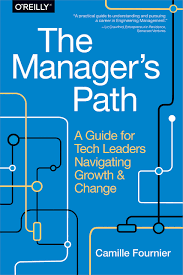The Manager's Path

The Manager's Path is one of the most recommended books in Engineering Management cicles. Looking at the table of contents, you can see that there's a chapter relevant to every stage of an engineering management career:
- Mentoring
- Tech Lead
- Managing People
- Managing a Team
- Managing Multiple Teams (Director)
- Managing Managers
- The Big Leagues (VP/SVP/CTO)
- Bootstrapping Culture
I don't have detailed highlights for this book since I read it as a paperback and not on Kindle, but here's a sampler of the kind of things this book talks about: very practical and actionable advice from someone who's seen it all.
- 1-1 meetings with your manager are an essential feature of a good working relationship. There are several distinct styles of 1-1 meetings, and the type of 1-1 that's the most effective depends as much on the manager as it does on the managed. It may be worth mixing it up between these 1-1 formats: the to-do list meeting, the catch-up, the feedback meeting, the progress report, and the getting-to-know-you.
- As you move from individual contributor (IC) to lead (i.e. either tech lead or manager), one of the biggest challenges is learning to balance your technical work vs. the non-technical work. For an IC, most of the work is technical; the higher up you go in your career, the more time you spend on communication, strategy, planning, management, and other non-technical issues.
- Delegation is not the same thing as abdication. When you’re delegating responsibility, you’re still expected to be involved as much as is necessary to help the project succeed.
- One of the basic rules of management is the rule of no surprises, particularly negative ones.
- Writing code is full of quick wins, especially for the experienced developer. You make tests pass, you see new features come to life, you get something to compile, you fix a problem. Management has fewer obvious quick wins, especially for new managers. It’s natural to feel some longing for simpler times, when it was just you and your computer and you didn’t have to deal with all these messy, complicated humans.
Fair warning: please don't bother reading the entire book cover-to-cover like I did despite the author herself recommending against it — reading just the section relevant to your career stage right now should be enough. There's a lot of repetition across the chapters — to the point that latter chapters will become almost unreadable. It's probably better to treat this book as a set of 10 independent blog posts, and pick and read the chapters you're interested in.
This is #56 in a series of book reviews published weekly on this site.